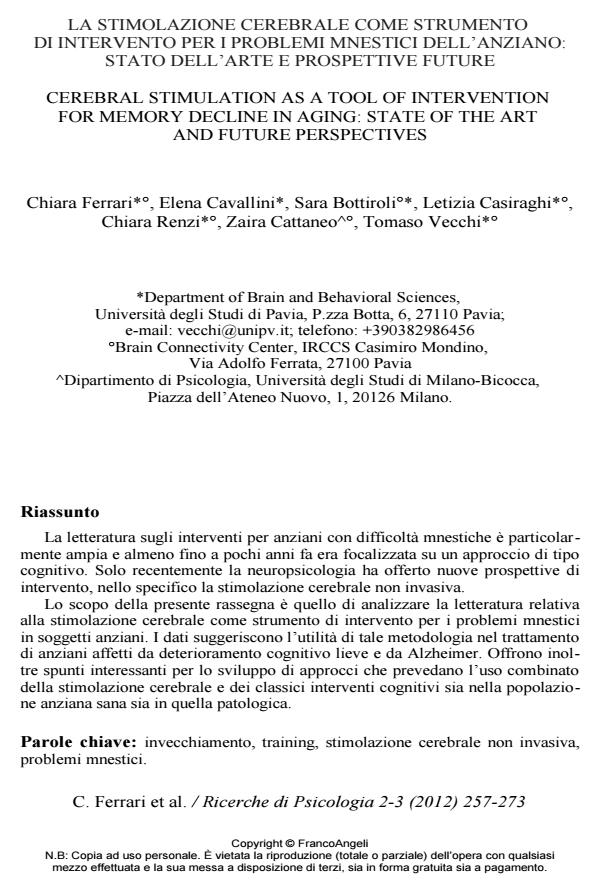La stimolazione cerebrale come strumento di intervento per i problemi mnestici dell’anziano: stato dell’arte e prospettive future
Titolo Rivista RICERCHE DI PSICOLOGIA
Autori/Curatori Chiara Ferrari, Elena Cavallini, Sara Bottiroli, Letizia Casiraghi, Chiara Renzi, Zaira Cattaneo, Tomaso Vecchi
Anno di pubblicazione 2013 Fascicolo 2012/2-3
Lingua Italiano Numero pagine 17 P. 257-273 Dimensione file 216 KB
DOI 10.3280/RIP2012-002008
Il DOI è il codice a barre della proprietà intellettuale: per saperne di più
clicca qui
Qui sotto puoi vedere in anteprima la prima pagina di questo articolo.
Se questo articolo ti interessa, lo puoi acquistare (e scaricare in formato pdf) seguendo le facili indicazioni per acquistare il download credit. Acquista Download Credits per scaricare questo Articolo in formato PDF

FrancoAngeli è membro della Publishers International Linking Association, Inc (PILA)associazione indipendente e non profit per facilitare (attraverso i servizi tecnologici implementati da CrossRef.org) l’accesso degli studiosi ai contenuti digitali nelle pubblicazioni professionali e scientifiche
La letteratura sugli interventi per anziani con difficolta mnestiche e particolarmente ampia e almeno fino a pochi anni fa era focalizzata su un approccio di tipo cognitivo. Solo recentemente la neuropsicologia ha offerto nuove prospettive di intervento, nello specifico la stimolazione cerebrale non invasiva. Lo scopo della presente rassegna e quello di analizzare la letteratura relativa alla stimolazione cerebrale come strumento di intervento per i problemi mnestici in soggetti anziani. I dati suggeriscono l’utilita di tale metodologia nel trattamento di anziani affetti da deterioramento cognitivo lieve e da Alzheimer. Offrono inoltre spunti interessanti per lo sviluppo di approcci che prevedano l’uso combinato della stimolazione cerebrale e dei classici interventi cognitivi sia nella popolazione anziana sana sia in quella patologica.
Parole chiave:Invecchiamento, training, stimolazione cerebrale non invasiva, problemi mnestici
Chiara Ferrari, Elena Cavallini, Sara Bottiroli, Letizia Casiraghi, Chiara Renzi, Zaira Cattaneo, Tomaso Vecchi, La stimolazione cerebrale come strumento di intervento per i problemi mnestici dell’anziano: stato dell’arte e prospettive future in "RICERCHE DI PSICOLOGIA " 2-3/2012, pp 257-273, DOI: 10.3280/RIP2012-002008